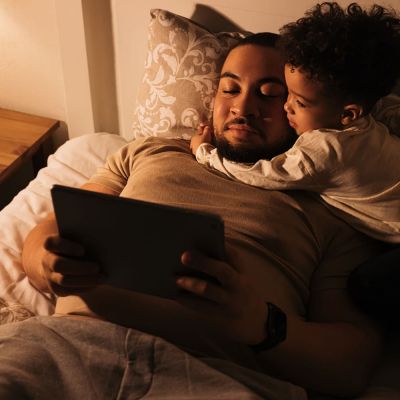By Amy Joyce for Washington Post
May 25, 2023, at 11:43 a.m. EDT
Recently, my husband and I had a talk with our teen boys about phones. There was too much mindless scrolling going on, and we had an idea. What if, we said, you plug your phones in downstairs, in the basement? And when you need them, you go downstairs, do what you need to do, come back. That includes texting, snapping friends, checking box scores.
The basement plan was intended to create a physical space between boy and phone, with us hoping the small barrier would be enough to deter them from constantly checking.
It lasted all of a couple days.
This week, U.S. Surgeon General Vivek H. Murthy issued an advisory that confirms what most of us teen parents have long known: Social media is hurting our kids. They are losing sleep, pulling away from real life, spending way too much time staring at a phone instead of doing … anything else. They are drawn to content that is making them anxious, depressed and unwell, and they can’t stop. Murthy called for technology companies to put better protections in place, to help us parents deal with this.
But pulling our kids away from social media is much easier said than done. According to Pew Research, 95 percent of teens between 13 and 17 have access to smartphones; Common Sense Media found that 84 percent of teens use social media. Among many parents, there’s a strong sense that the genie is already out of the bottle — this stuff is everywhere, and even without a phone, our kids would still find ways to access the platforms we want to keep them away from. When I mentioned our abandoned basement plan to a friend, she said to me, “Wow, you’re still actually trying to rein it in? I just figured at this age we give up.”
But I have learned over the years that if my husband and I feel our kids are on their screens too much, they’re probably feeling it too: That same Common Sense Media report also indicated that only 34 percent of teens who use social media say they enjoy it “a lot.” Not all social media is bad — it can be a way for tweens and teens to connect to other like-minded peers, to keep in touch with far-flung friends, to communicate beliefs and feed new interests. But as most of us have experienced, once our kids are sucked in, it’s enormously difficult to pull them back. However, it’s not impossible, and as evidenced by Murtha’s report and dire warning, the stakes are so high that parents have to try.
What teens think parents should know about phones
And so for those of us who have allowed our kids to have a phone and social media (most of us), how do we walk it back now? What do we wish we had known, as Melinda French Gates once said in an article here, “before putting a computer in my children’s pockets”? It might take stronger boundaries at home, it might take recruiting other parents to join in the battle and it will definitely take more effort on the part of tech companies. But to be sure: The struggle between letting our kids have a phone and begging them to put it down is real.
For many parents, it’s the idea that their children are the only ones who don’t have a phone or aren’t on a certain social media site that pushes them to allow it in the first place. Abigail Cannon of Bend, Ore., finally allowed her son, 14, to have Snapchat around January because the rest of his hockey team was using it. “I’m already regretting it,” she said. “It hit that perfect parental piano key where I thought ‘Oh, he’s being left out.”
But now he’s using it to watch “totally unfiltered content that just consumes all of his interest and focus… So all the healthy limits we had worked so hard to have, it’s just more slippery than anything else we’ve ever dealt with,” Cannon said. “I can’t even figure out how to use screentime limits for Snap. Truly, it’s run by aliens.”
The Cannon family rules? Constant checks to make sure screen limits are in place. No phones at meals. No phones in rooms at night. (She is, after all, a pediatric sleep coach.) And yes, they are rethinking Snapchat. Cannon is considering talking to the parents of her son’s teammates. “Can we recruit the group of friends who matter to him most to stop? It has to be a community effort rather than individual.”
As a parent, she’s tired of all the vigilance, and she thinks a lot about how absorbing the app is. “I really wonder if it’s just a profound distraction that might be [keeping him from something] that could be interesting to him.”
The fact is, say experts and parents alike, when teens are given boundaries around phones, they feel relief. “If kids really sat there and took stock of how they feel when they’re on their devices, they would notice a drop in feeling good about themselves,” says Jennifer Kelman, a mental health expert with Just Answer, and clinical social worker specializing in children’s mental health. “We all think our kids don’t want discipline and boundaries, but they do. … If we just let them have free rein, they feel out of control.”
Worried about your kids’ screen time? Check your own first.
Schenley Walker says she was the “last parent standing” in San Francisco, as her kids didn’t get phones until their first year of high school. “The idea that we’re running this giant experiment on kids has always resonated with me,” she says. “We’ve dramatically changed how people interact in a short period of time.”
She delayed as long as possible, in part by sending her kids to summer camp without devices. “The break they have in the summer is key, because that’s taught them from age 10: Look at this rich life I can have when I … can engage in the world instead of a screen.”
Handing a phone to her children at older ages has helped them regulate their usage, she believes. Her son, a 20-year-old college student, has a phone but seems uninterested in social media. Her daughter, finishing her junior year of high school, participates in social media, but it hasn’t taken over her life, and there are no restrictions from her parents. “She’s 17. At this point, she needs to figure out on her own what works for her with minimal guidance,” Walker said. “What I do like is she has a set of friends who like to be together when they’re in person.”
The report released this week points to two major issues: Content and problematic screen use, says Lisa Damour, a psychologist and author of “The Emotional Lives of Teenagers.”
“It’s critically important that we talk to kids about what they’re exposed to through digital technology — and these should be ongoing conversations,” she said. “There are benign digital spaces, and there are incredibly dangerous digital spaces, such as those that promote eating disorder behavior, misogyny, racism and self-harm.”
And we need to have open conversations with our children about the time spent on screens, she said. “Technology should not interfere with sleep, physical activity, in-person time, contributing around the house and in one’s community.”
So how do we parents have these conversations in productive ways? Read the report, she says. Then print it out and talk about it with your teen. If they argue against new boundaries, explain that new information is coming to light “and in all things, we work with the most recent information.”





